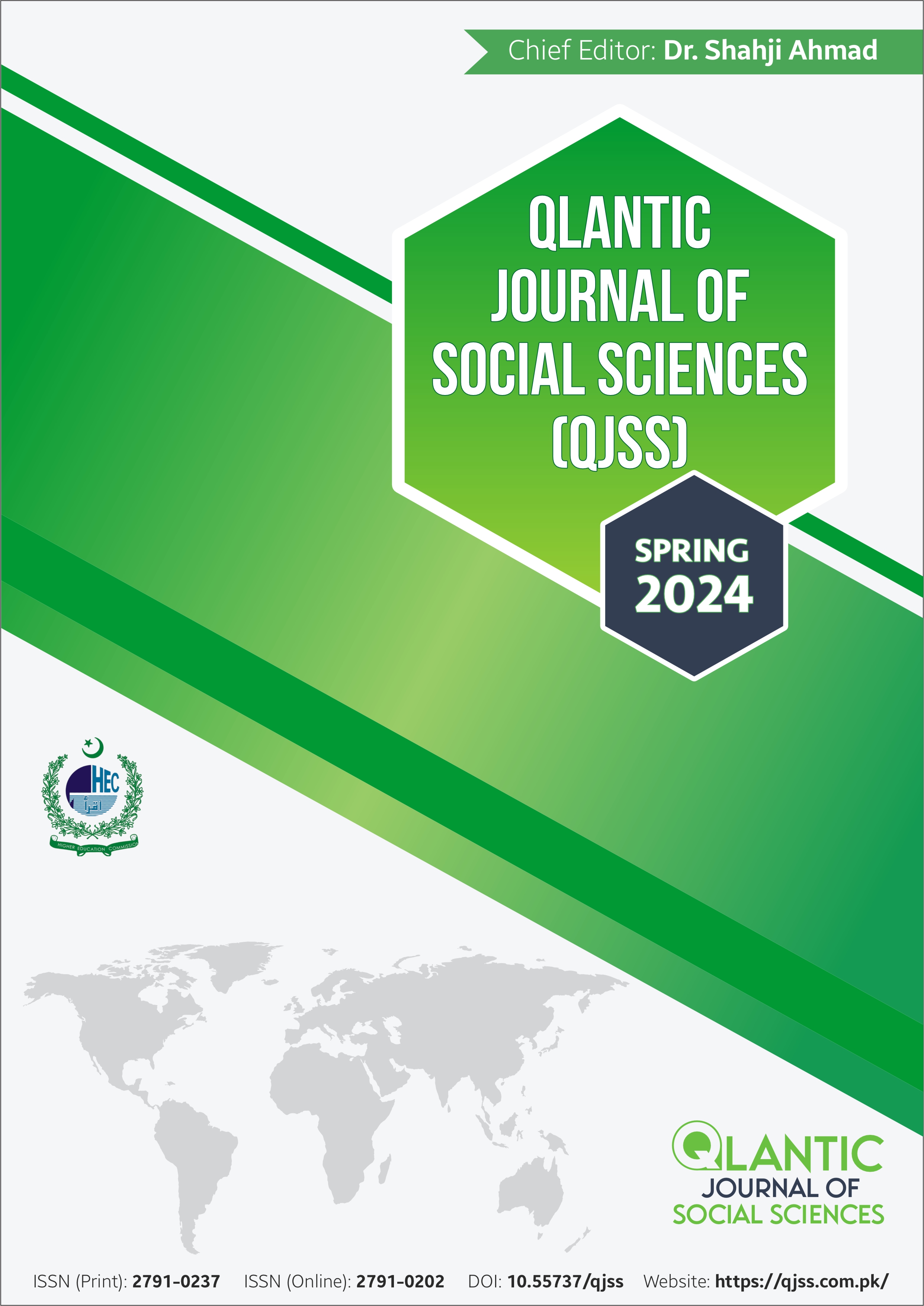Effect of Cooperative Learning on Grade VII Learners’ Creative Thinking Skills (CTSS) in Elementary School Science
DOI:
https://doi.org/10.55737/qjss.113973416Keywords:
Cooperative Learning, Creative Thinking Skills (CTSs), Elementary School ScienceAbstract
In every aspect of daily life, uniforms are fundamental. When we meet someone, we tend to judge them based on their uniform, such as a nurse's outfit, a labourers’ uniform, or a military uniform. "School uniform influences students’ social adjustment at secondary school level in district Bannu, KPK, Pakistan", is the main focus of this study. Due to its descriptive nature, a survey approach was used. The population of the study is 8073 male students enrolled in district Bannu's Government Secondary Schools. The applied sampling technique was a stratified random sampling technique. Five hundred respondents were selected as a sample, and the data was calculated using the John Curry (1984) formula. The "Five Point Likert Scale” was employed in a self-created survey instrument. The researcher made 41 statements and requested a panel of ten educational experts for validation. The researcher gave the questionnaire to fifty students. Utilized SPSS’s Cranach alpha to assess the questionnaire's reliability. Overall, Cranach's alpha was .83. Out of all 30 items that remained for the data collection, 11 were irrelevant because their "corrected item-total correlation" standards were less than .25. To find out "school uniform" and "social adjustment", frequency and percentage were employed. The effect was ascertained by Simple Linear Regression which shows that school uniforms significantly influence students’ social adjustment in the community at secondary school level in district Bannu.
References
Andin, C., & Aziz, A. (2019). Thinking effects of cooperative learning on students’s higher order. International Journal of Recent Technology and Engineering, 7(6S5), 744-747. https://www.ijrte.org/portfolio-item/F11290476S519/
Betancur, J. A., Rodriguez, C., & Ezparragoza, I. (2011). An undergraduate collaborative design experience among institutions in the Americas. In Proc. 8th WSEAS International Conference on Engineering Education (EDUCATION '11), Corfu Island, Greece, pp. 263- 265.
Cai, D. J., Mednick, S. A., Harrison, E. M., Kanady, J. C., & Mednick, S. C. (2009). REM, not incubation, improves creativity by priming associative networks. Proceedings of the National Academy of Sciences of the United States of America, 106(25), 10130–10134. https://doi.org/10.1073/pnas.0900271106
Franken, R. E. (2007). Human motivation. 3rd Edn., Northridge: California State University Guilford, J. P. (1950). Creativity. American Psychologist, 5, 444–454. https://doi.org/10.1037/h0063487
Gunawan, G., Sahidu, H., Harjono, A., & Suranti, N. M. (2017). Efektivitas Penerapan model project based learning Berbantuan media virtual terhadap Kreativitas Fisika Peserta Didik. Jurnal Cakrawala Pendidikan, 36(2). https://doi.org/10.21831/cp.v36i2.13514
Gunawan, N., Harjono, A., Sahidu, H., & Nisrina, N. (2018b). Improving students’ creativity using cooperative learning with virtual media on static fluida concept. Journal of Physics. Conference Series, 1006, 012016. https://doi.org/10.1088/1742-6596/1006/1/012016
Gunawan, N., Harjono, A., Sahidu, H., & Nisrina, N. (2018). Improving students’ creativity using cooperative learning with virtual media on static fluida concept. Journal of Physics. Conference Series, 1006, 012016. https://doi.org/10.1088/1742-6596/1006/1/012016
Halford, G. S. & Wilson, W. H. (2002). Creativity, relational knowledge and capacity: Why are humans so creative? In Terry, D (ed.), Creativity, cognition and knowledge. London: Greenwood Publishing Group. pp: 153-168
Hasan, R., Lukitasari, M., Utami, S., & Anizar, A. (2019). The activeness, critical, and creative thinking skills of students in the Lesson Study-based inquiry and cooperative learning. Jurnal Pendidikan Biologi Indonesia, 5(1), 77–84. https://doi.org/10.22219/jpbi.v5i1.7328
John, E. B. & Meera, K. P. (2014). Effect of cooperative learning strategy on the creative thinking skills of secondary school students of Kozhikode District. IOSR Journal of Humanities and Social Science, 19(11), 70-74.
Kampylis, P., & Berki, E. (2014). Nurturing creative thinking. Geneva: Unesco. http://www.ibe.unesco.org/sites/default/files/resources/edu-practices_25_eng.pdf
Kaufman, J. C., & Sternberg, R. J. (2019). The Cambridge Handbook of Creativity (Cambridge Handbooks in Psychology) (2nd ed.). Cambridge University Press
Latour, B. & Woolgar, S. (1986). Laboratory life: The construction of scientific facts. Princeton. NJ: Princeton University Press.
Leasa, M., Batlolona, J. R., & Talakua, M. (2021). Elementary students’ creative thinking skills in science in the Maluku Islands, Indonesia. Creativity Studies, 14(1), 74–89. https://doi.org/10.3846/cs.2021.11244
Marashi, H., & Khatami H. (2017). Using cooperative learning to boost creativity and motivation in language learning. Journal of Language and Translation, 7, 1(13), 43-58. https://journals.iau.ir/article_529573_7dcf06f1f8f0f9222e44bc6e5cb4b653.pdf
Orora, W., Keraro, F. N., & Wachanga, S. W. (2014). Using Cooperative E-Learning teaching strategy to Enhance students’ creativity in secondary school biology: A study of selected schools in Nakuru County, Kenya. International Journal of Education and Practice, 2(6), 137–146. https://doi.org/10.18488/journal.61/2014.2.6/61.6.137.146
Pun, S. (2012). Collaborative Learning: A means to creative thinking in design. International Journal of Education and Information Technologies, 6(1), 33-43. https://hdl.handle.net/10356/94536
Scibinetti, P., Tocci, N., & Pesce, C. (2011). Motor creativity and creative thinking in children: The diverging role of inhibition. Creativity Research Journal, 23(3), 262–272. https://doi.org/10.1080/10400419. 2011.595993
Sekhri, A., & Kaur, K. (2021).Cooperative learning and breakout rooms in online classrooms: Increasing student engagement and developing creativity. Palarch’s Journal of Archaeology of Egypt/Egyptology, 18(8), 3463-3469.
Silva, H., Lopes, J., Dominguez, C. Morais, E. (2022). Lecture, cooperative learning and concept mapping: any differences on critical and creative thinking development? International Journal of Instruction, 15(1), 765-780.
Stoican, M., & Camarda, A. L. (2011). Innovation economy and the importance of human capital in the developed countries. International Journal of Education & Information Technologies, 5(4), 369-376.
Syafrial., Ashadi., Saputro, S., & Sarwanto (2022). Trend creative thinking perception of students in learning natural science: Gender and domicile perspective. International Journal of Instruction, 15(1), 701-716. https://doi.org/10.29333/iji.2022.15140a
Torrance, E. P. (1965). Scientific views of creativity and factors affecting its growth. Creativity and Learning, 94(3), 663–681.
Vidergor, H. E. (2018). Effectiveness of the multidimensional curriculum model in developing higherorder thinking skills in elementary and secondary students. The Curriculum Journal, 29(1), 95–115. https://doi.org/10.1080/09585176.2017.1318771
Yasin, B., Rasool, S., Azim. M. (2021). Effect of cooperative learning strategies on students’ learning. Pakistan Social Sciences Review, 5(4), 499-510. https://pssr.org.pk/issues/v5/4/effect-of-cooperative-learning-strategies-on-students-learning.pdf
Zimmerman, E. (2010). Creativity and Art Education: a personal journey in four acts. Art Education, 63(5), 84–92. https://doi.org/10.1080/00043125.2010.11519093




